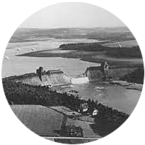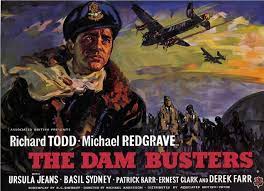One of the great Sunday movies, The Dam Busters was undoubtedly one of the first war films I watched as a child, and it was probably shown on a Sunday afternoon or in the Christmas holidays. The Dam Busters’ music, specifically the Dam Busters’ March is known by many. The music itself has become part of British culture as it is often ‘sung’ at football matches.
The raid itself has become a trope in other films, probably most noticeably with the attack on the Death Star in Star Wars but also an advert for a certain beer where a German guard drank some beer and then caught the bouncing bombs as if he was a goalkeeper.
The film is based on two books
These are (As an Amazon Associate I earn from qualifying purchases) The Dam Busters by Paul Birkhill and Enemy Coast Ahead by Guy Gibson who was awarded the Victoria Cross for leading this mission. There have been many other books and documentaries, and a potential remake by Peter Jackson has been rumoured for years. We shall see if that actually materialises. In this, the 80th anniversary of the operation, it’s worth another watch.
The Dam Busters 1955
‘The Dam Busters is the first film in this study to portray a true event from the Second World War and it concerns the development and use of the bouncing bomb in Operation Chastise. The story begins in 1942 with inventor Barnes Wallace (Leslie Howard) attempting to develop an idea for a new kind of bomb. The targets for the bomb, once developed, were the large dams providing water for the industries of the Ruhr region of Germany.
Wallace’s stubborn devotion and self-belief in his radical idea initially force him to fight his bureaucratic superiors and their red tape to get support for his plan. Eventually, he succeeds, and the raid is set in motion with the creation of 617 Squadron, led by Wing Commander Guy Gibson (Richard Todd). 
The story then follows the final development of the bomb and the training of the new squadron. Both parts of the task encounter various setbacks in the short run-up to the raid. During testing, the bomb keeps breaking up as it hits the water. The squadron, whilst practising low flying, discovers the difficulty of flying at the right altitude to drop the bomb at night at the right distance away to reach the dam at the right part of the bounce.
Two of the dams, the Möhne and Eder Dams were destroyed and the Sorpe was lightly damaged. However, when Wallace finds out, he is immediately struck with grief because of the bomber’s losses. Up until this time, the problem of destroying the dams had manifested itself only on an academic level. He had not considered the possible losses. When the reality of the human losses becomes evident such naivety is destroyed but Gibson reminds Wallace, “If all those fellows had known from the beginning that they would not be coming back, they’d have gone for it just the same. There isn’t a single one of them would have dropped out. I knew all of them, I know it’s true.”
The psychological cost
Wallace’s heroic credentials are on the verge of being destroyed but Gibson is able to restore his faith and the ensuing credits enable the audience to maintain the feeling of achievement avoiding any major consideration of the morality or military necessity of the raid.
Therefore, The Dambusters maintains the wartime theme that every Allied mission was right and decent despite the post-war historical debate about whether the riad caused damage to the German war effort. However, there are two factors where the film is significant. The first is the film’s use of technology and the second is the character representation and political influences of the time. Certain aspects of the film highlight the limits of technology at the time of its production. The most notable example, which adversely affects the realism of the film, is when the bombs explode and cause plumes of water, which are clearly superimposed. Though to balance this technically weak footage, scenes of actual test drops [though edited] are used earlier in the film.
How does it fit with the other films?
Its production in 1955 shows a continuation of nationalistic ideals that had been promoted in wartime. Though there are no German characters to directly compare with the heroic British civil and military personnel. Produced after the Korean War and in the first years of the Cold War, Soviet Russia was the new enemy and West Germany was now an ally. Thus, the earlier films highlighting Germany as the manifestation of evil are already dated. The destruction of the dams is more important than killing Germans. The film is therefore pro-British rather than anti-German.’
The next film is based on the Cornelius Ryan book, The Longest Day.
Final thoughts
As with all these films from my thesis, I found a lot of what I wrote all those years ago quite painful to read, and not just because of the spelling and lack of commas. I overuse the word naïve and that ironically describes my approach to the films and writing about them. I do remember that I set a goal of writing a thousand words on each film of which there were fourteen in total. I am not sure why this one fell so short, so if I redid this piece of work (which I’m sometimes tempted to do), I’d probably redo much of what I wrote but the critique of this film would probably have the most significant changes made to it.

If you have not seen it, it doesn’t just have to be Sunday afternoon viewing, it is great enough to watch it anytime. So, get the snack of your choice, get your fingers ready to put on your pretend flying goggles (if you know, you know) and sit back and watch a story of British grit, determination, and ingenuity.
Then maybe ponder if it was worth it to lose all those crews, what effect the destruction of the dams had on the war, and if it is still actually one of the all-time great Second World War films. I have some feelings on the matter, but what are yours?
Cheers for now
BigT
